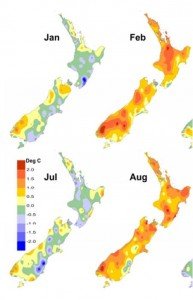 The National Institute of Water and Atmospheric Research (NIWA) issued its annual report on New Zealand’s climate today, highlighting the warmest, wettest, driest and sunniest places in 2010.
The National Institute of Water and Atmospheric Research (NIWA) issued its annual report on New Zealand’s climate today, highlighting the warmest, wettest, driest and sunniest places in 2010.
The year began with a moderate El Niño, transitioning to the opposite La Niña pattern by July and strengthening through the end of 2010. Prevailing westerlies supported an increased number of anticyclones, leading to relatively settled weather.
Above-average to average temperatures were seen in all regions, with 2010 clocking in as the fifth warmest year since 1900.
The full climate summary report can be downloaded here.
Some ‘topline’ points are:
* Increased anticyclones (‘highs’) brought relatively settled conditions.
* The broad climate setting switched from moderate El Nino early in the year to a La Nina by July. The La Nina had become moderate-to-strong by September.
* 2010 was the 5th warmest year since 1900, with average annual temperature of 13.1 deg C. The four warmer years were 1971, 1998, 1999, and 2005.
* Notable climate features included two droughts, several heat waves, and three significant rainfall events.
Some ‘podium finishers’ (in order: 1,2,3):
* Sunniest: Whakatane, Nelson, Blenheim
* Warmest: Whangaparaoa, Whangarei, Kaitaia
* Coldest: Mt Ruapehu, Lake Tekapo, Mt Cook
* Wettest: Cropp River, Doon, North Egmont
* Driest: Clyde, Ranfurly, Alexandra
Note – these are climate stations for which all data are available. For complete lists, please see the full document.
Some records:
* Highest temperature: 35.6 deg C at Cheviot on 22 Feb
* Lowest temperature: -12.6 deg C at Lake Tekapo on 10 Aug
* Highest recorded wind gust: 217 km/hr at Baring Head (near Wellington) on 12 March
* Most rain in a single day: 314 mm at Milford Sound on 25 April
The main centres:
* Sunniest: Tauranga (2414 hours)
* Wettest: Wellington (1503 mm)
* Driest: Christchurch (660 mm)
* Warmest: Auckland (15.9 deg C)